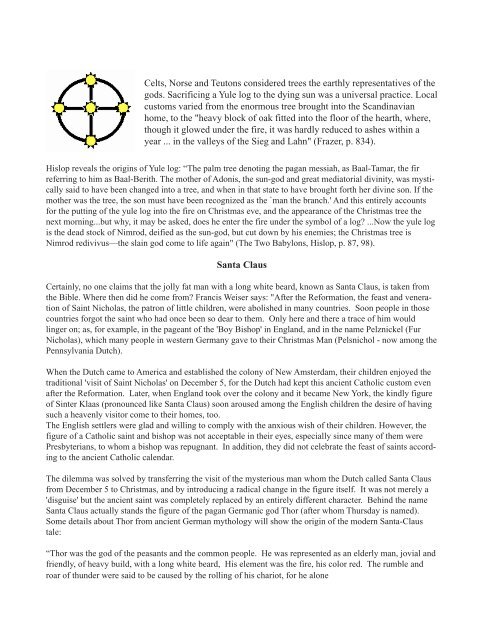Is Christmas Christian? By Peter Salemi - British-Israel Church of God
Is Christmas Christian? By Peter Salemi - British-Israel Church of God
Is Christmas Christian? By Peter Salemi - British-Israel Church of God
Create successful ePaper yourself
Turn your PDF publications into a flip-book with our unique Google optimized e-Paper software.
Celts, Norse and Teutons considered trees the earthly representatives <strong>of</strong> thegods. Sacrificing a Yule log to the dying sun was a universal practice. Localcustoms varied from the enormous tree brought into the Scandinavianhome, to the "heavy block <strong>of</strong> oak fitted into the floor <strong>of</strong> the hearth, where,though it glowed under the fire, it was hardly reduced to ashes within ayear ... in the valleys <strong>of</strong> the Sieg and Lahn" (Frazer, p. 834).Hislop reveals the origins <strong>of</strong> Yule log: “The palm tree denoting the pagan messiah, as Baal-Tamar, the firreferring to him as Baal-Berith. The mother <strong>of</strong> Adonis, the sun-god and great mediatorial divinity, was mysticallysaid to have been changed into a tree, and when in that state to have brought forth her divine son. If themother was the tree, the son must have been recognized as the `man the branch.' And this entirely accountsfor the putting <strong>of</strong> the yule log into the fire on <strong>Christmas</strong> eve, and the appearance <strong>of</strong> the <strong>Christmas</strong> tree thenext morning...but why, it may be asked, does he enter the fire under the symbol <strong>of</strong> a log? ...Now the yule logis the dead stock <strong>of</strong> Nimrod, deified as the sun-god, but cut down by his enemies; the <strong>Christmas</strong> tree isNimrod redivivus—the slain god come to life again" (The Two Babylons, Hislop, p. 87, 98).Santa ClausCertainly, no one claims that the jolly fat man with a long white beard, known as Santa Claus, is taken fromthe Bible. Where then did he come from? Francis Weiser says: "After the Reformation, the feast and veneration<strong>of</strong> Saint Nicholas, the patron <strong>of</strong> little children, were abolished in many countries. Soon people in thosecountries forgot the saint who had once been so dear to them. Only here and there a trace <strong>of</strong> him wouldlinger on; as, for example, in the pageant <strong>of</strong> the 'Boy Bishop' in England, and in the name Pelznickel (FurNicholas), which many people in western Germany gave to their <strong>Christmas</strong> Man (Pelsnichol - now among thePennsylvania Dutch).When the Dutch came to America and established the colony <strong>of</strong> New Amsterdam, their children enjoyed thetraditional 'visit <strong>of</strong> Saint Nicholas' on December 5, for the Dutch had kept this ancient Catholic custom evenafter the Reformation. Later, when England took over the colony and it became New York, the kindly figure<strong>of</strong> Sinter Klaas (pronounced like Santa Claus) soon aroused among the English children the desire <strong>of</strong> havingsuch a heavenly visitor come to their homes, too.The English settlers were glad and willing to comply with the anxious wish <strong>of</strong> their children. However, thefigure <strong>of</strong> a Catholic saint and bishop was not acceptable in their eyes, especially since many <strong>of</strong> them werePresbyterians, to whom a bishop was repugnant. In addition, they did not celebrate the feast <strong>of</strong> saints accordingto the ancient Catholic calendar.The dilemma was solved by transferring the visit <strong>of</strong> the mysterious man whom the Dutch called Santa Clausfrom December 5 to <strong>Christmas</strong>, and by introducing a radical change in the figure itself. It was not merely a'disguise' but the ancient saint was completely replaced by an entirely different character. Behind the nameSanta Claus actually stands the figure <strong>of</strong> the pagan Germanic god Thor (after whom Thursday is named).Some details about Thor from ancient German mythology will show the origin <strong>of</strong> the modern Santa-Claustale:“Thor was the god <strong>of</strong> the peasants and the common people. He was represented as an elderly man, jovial andfriendly, <strong>of</strong> heavy build, with a long white beard, His element was the fire, his color red. The rumble androar <strong>of</strong> thunder were said to be caused by the rolling <strong>of</strong> his chariot, for he alone


